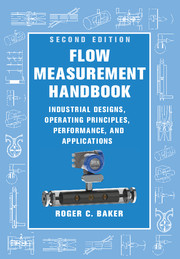Book contents
- Frontmatter
- Dedication
- Contents
- Preface
- Acknowledgements
- Nomenclature
- 1 Introduction
- 2 Fluid Mechanics Essentials
- 3 Specification, Selection and Audit
- 4 Calibration
- 5 Orifice Plate Meters
- 6 Venturi Meter and Standard Nozzles
- 7 Critical Flow Venturi Nozzle
- 8 Other Momentum-Sensing Meters
- 9 Positive Displacement Flowmeters
- 10 Turbine and Related Flowmeters
- 11 Vortex Shedding, Swirl and Fluidic Flowmeters
- 12 Electromagnetic Flowmeters
- 13 Magnetic Resonance Flowmeters
- 14 Ultrasonic Flowmeters
- 15 Acoustic and Sonar Flowmeters
- 16 Mass Flow Measurement Using Multiple Sensors for Single-Phase Flows
- 17 Multiphase Flowmeters 508
- 18 Thermal Flowmeters
- 19 Angular Momentum Devices
- 20 Coriolis Flowmeters
- 21 Probes for Local Velocity Measurement in Liquids and Gases
- 22 Verification and In Situ Methods for Checking Calibration
- 23 Remote Data Access Systems
- 24 Final Considerations
- References
- Main Index
- Flowmeter Index
- Flowmeter Application Index
8 - Other Momentum-Sensing Meters
Published online by Cambridge University Press: 05 August 2016
- Frontmatter
- Dedication
- Contents
- Preface
- Acknowledgements
- Nomenclature
- 1 Introduction
- 2 Fluid Mechanics Essentials
- 3 Specification, Selection and Audit
- 4 Calibration
- 5 Orifice Plate Meters
- 6 Venturi Meter and Standard Nozzles
- 7 Critical Flow Venturi Nozzle
- 8 Other Momentum-Sensing Meters
- 9 Positive Displacement Flowmeters
- 10 Turbine and Related Flowmeters
- 11 Vortex Shedding, Swirl and Fluidic Flowmeters
- 12 Electromagnetic Flowmeters
- 13 Magnetic Resonance Flowmeters
- 14 Ultrasonic Flowmeters
- 15 Acoustic and Sonar Flowmeters
- 16 Mass Flow Measurement Using Multiple Sensors for Single-Phase Flows
- 17 Multiphase Flowmeters 508
- 18 Thermal Flowmeters
- 19 Angular Momentum Devices
- 20 Coriolis Flowmeters
- 21 Probes for Local Velocity Measurement in Liquids and Gases
- 22 Verification and In Situ Methods for Checking Calibration
- 23 Remote Data Access Systems
- 24 Final Considerations
- References
- Main Index
- Flowmeter Index
- Flowmeter Application Index
Summary
Introduction
The previous chapters have been mainly concerned with devices, the designs of which have been defined by various standard specifications. In this chapter, we consider other mainly proprietary meters, which depend on the changing flow pattern and which essentially sense momentum of the flow. The output is in some cases given by a differential pressure measurement and in others by a position or force measurement. This means that the user must be aware of the possible effect of density on the results. Viscosity will also affect some readings.
The somewhat arbitrary order of consideration and the uneven amount of detail in this chapter reflect the available literature and my experience. Thus the variable area meter takes up a large proportion of this chapter.
The meters considered in this chapter are:
•variable area (VA) meters, which depend on gravity to oppose the movement of the float and consist of two main types:
• those with a tapered tube and a float with a fixed metering edge and
• those with an orifice with a fixed metering edge and a moving tapered plug;
• spring-loaded profiled plug in an orifice;
• target (drag plate) meter sometimes spring loaded;
• Venturi-type meters claiming a low loss, such as Dall, Epiflo, Gentile and Low-Loss;
• wedge meter;
• V-cone meters;
• meters using a bypass with an oscillating vane, a Pelton or a VA meter in it;
• slotted orifice meter;
• pipework features used as meters such as inlets and bends;
• averaging pitots under various names (Annubar, Torbar etc.); and
• laminar (viscous) flowmeters.
Variable Area Meter
The variable area (VA) meter is sometimes known as a Rotameter, but this is a trade name of a particular company and I shall, therefore, refer to it as the variable area meter. In the following sections on the VA meter, I have avoided history, theory or other items, which have been consigned to Appendix 8.A. One way to view the VA meter is as a variable orifice meter with a fixed pressure drop resulting from the weight of the float.
- Type
- Chapter
- Information
- Flow Measurement HandbookIndustrial Designs, Operating Principles, Performance, and Applications, pp. 195 - 233Publisher: Cambridge University PressPrint publication year: 2016



